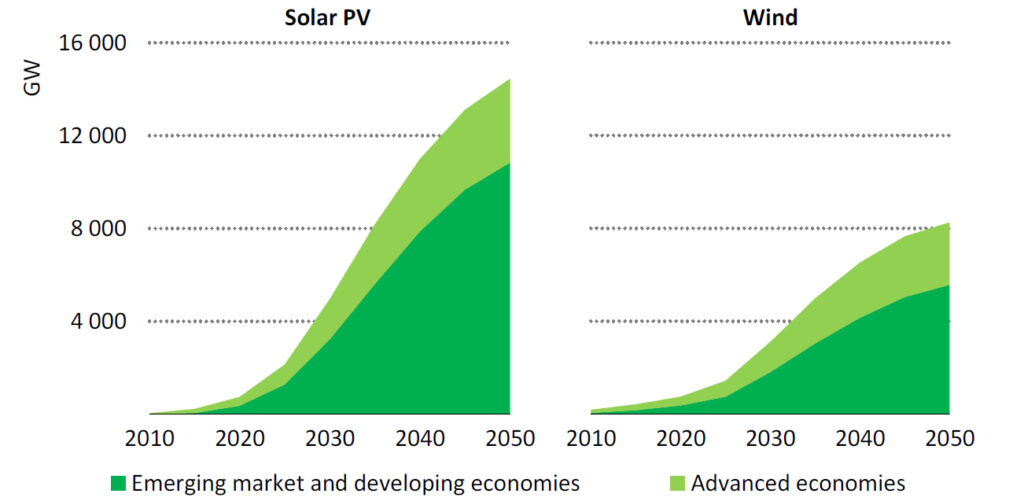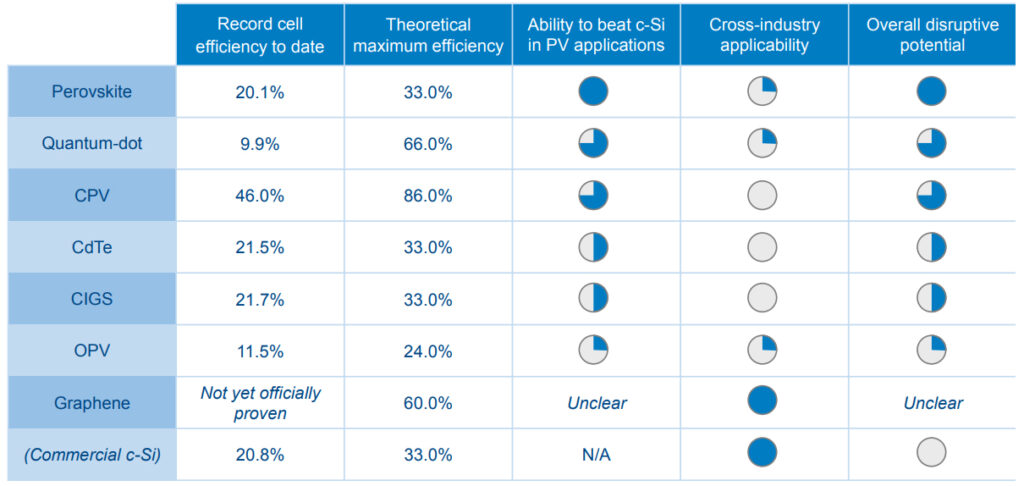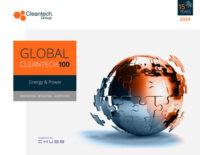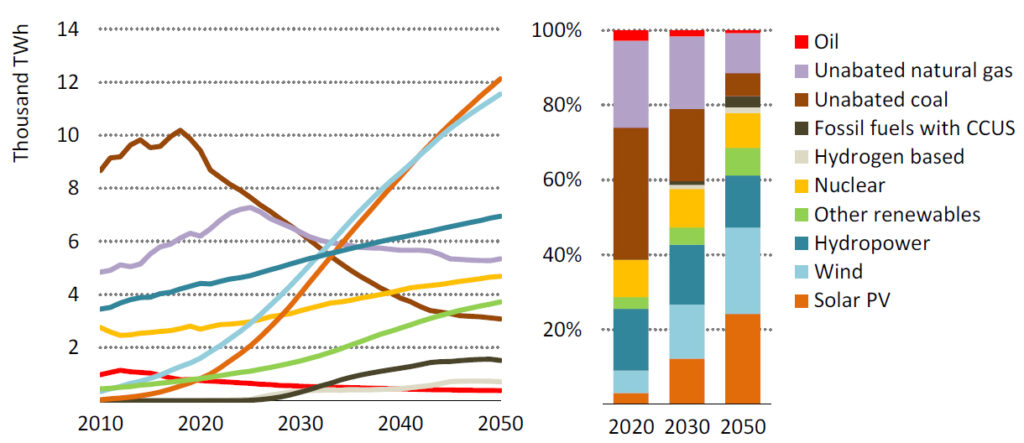Perovskites: Finding a Foothold for Thin Film Solar
The Global Solar Challenge
Solar PV plays a key role in the decarbonization of the energy sector. To meet 2050 net-zero goals, the IEA projects that solar PV must account for 35% of the overall global energy mix, with renewables — namely solar and wind — making up about 90% of all energy generation.
To stay in line with these net-zero scenarios, global solar capacity must increase 20-fold from now until 2050. This equates to deploying over 600GW of solar PV every year. Although 2022 was a record-breaking year for solar PV, only 268 GW were deployed globally, far short of net-zero targets.
Renewables Deployment for Net-Zero Scenario

Currently, crystalline silicon PV makes up the vast majority (over 90%) of the solar PV module market. Several characteristics of crystalline silicon pose obstacles to the exponential increase in PV deployment needed for the decarbonization of the energy sector.
Primarily, crystalline silicon conversion efficiency has topped out at around 22%, which is insufficient to support the increasing demands for renewable energy from electrifying sectors (i.e., EV charging). Additionally, crystalline silicon PV requires steady, strong sunlight for optimal performance, and due to the rigidity and weight of these modules, installation can be cost-intensive and optimal installation sites are limited.
Thin Film Solar
Thin film solar are PV cells a fraction of the width and weight of conventional PV, which address the challenges facing silicon PV. Due to their flexibility, light weight, and improved low-light performance, thin film solar can be deployed in areas where silicon PV is not feasible (e.g., building facades, infrastructure, or low irradiance zones).
However, existing thin film technologies have encountered several obstacles to reach commercial scale and meaningfully support global solar deployment. These challenges include materials scarcity, toxicity, and supply chain disruptions, as well as engineering and performance issues, and cost inefficiency. Innovative thin film technology such as perovskites addresses these challenges and innovators are now reaching commercialization stages.
Comparison of Thin Film Solar Technologies

Source: Arthur D. Little
Thin Film Innovation: Perovskites
Perovskites are materials with varying composition that share a specific crystal structure. Perovskite thin film cells have the capacity to absorb a very wide spectrum of visible light, leading to comparably high conversion efficiency compared to other thin film technologies. Additionally, manufacturing of perovskites uses abundant earth materials and a relatively simple and low-energy process.
Key Dynamics
Peroviskites:
- Are a class of compositionally variable materials that share a crystal structure with calcium titanium oxide.
- Use an inexpensive manufacturing process — use of existing high throughput equipment from other industries (e.g., semiconductors, printing) improves economics of deployment.
- Have no materials limitations/rare earth materials – streamlined and resilient supply chain
- Have a rapidly improving conversion efficiency: from less than 4% in the early 2000’s to 15%-17% today.
- Have a challenge of exposure to oxygen and degradation that has been addressed through encapsulation.
- Are ideal for tandem silicon modules. The addition of perovskite-treated glass to silicon PV cells:
- Can increase efficiency of silicon cells 20-30% — overall tandem module can reach over 30%.
- Requires no manufacturing changes to silicon PV cell -swap out clear glass for perovskite-treated glass.
- Can absorb wide spectrum of visible light that can be extracted at a high rate — key for tandem modules.
- Unlocks solar power in low-irradiance geographies and meets increasing demand from electrifying sectors.
The efficiency of perovskite solar cells has increased significantly in the past five-to-ten years, from less than 4% to 15-20% (20% in lab testing) from innovators such as Tandem PV (U.S.) and Microquanta (China). Even though still less efficient, reduced manufacturing and material costs of perovskites and thin film, in general, results in a competitive LCOS compared to conventional silicon PV. While silicon efficiency has plateaued, innovators project that perovskite efficiencies will continue to improve over the coming years.
Due to their electrical and optical qualities, perovskite PV is particularly suited for tandem silicon PV modules. Innovators like Caelux (U.S.) and Cubic PV (U.S.) add a layer of perovskite PV onto the solar glass used in conventional silicon PV, which can increase the overall module efficiency by 20-30%.
These tandem perovskite-silicon PV modules offer a solution to both increase the efficiency of PV to meet increasing electrical demand as well as to improve the overall cost-efficiency of installation. Tandem modules can be easily incorporated into existing manufacturing processes of silicon PV, simply swapping out conventional solar glass for perovskite-coated glass.
Look Out For Novel Perovskite and Thin Film Applications
While there are many potential applications for perovskite thin film solar cells, tandem modules currently have the most market traction, offtakers, and path to commercialization. As innovators approach commercialization, partnerships with incumbent silicon PV manufacturers could rapidly scale the market uptake of tandem solar modules.
Commercialization and scaling of perovskite silicon tandem modules could greatly improve the unit economics of perovskite thin film and pave the way for more novel applications of thin film to reach the market including those for self-charging electronics (e.g., Saule Technologies), clothing and textiles, windows and building-integrated PV, solar ink (e.g., Solaire) and space-based applications. Other companies to watch for innovation in thin film include those creating organic PV (e.g., Heliatek), quantum dot solar cells (e.g., Quantum Materials), and dye-sensitized solar cells (e.g., Ubiquitous Energy).




